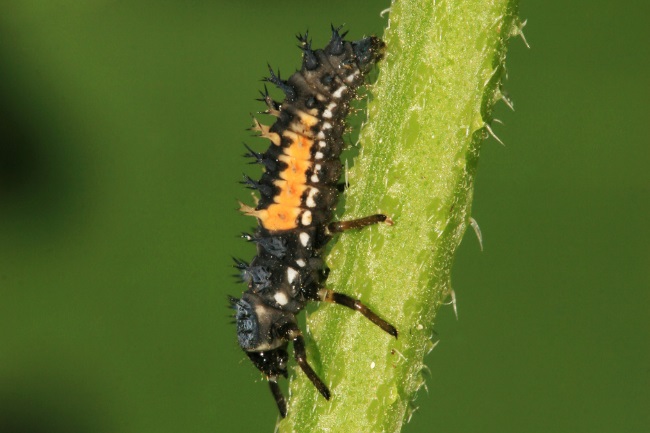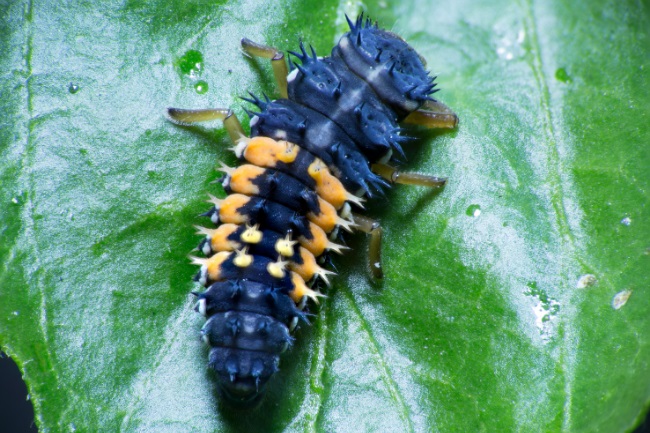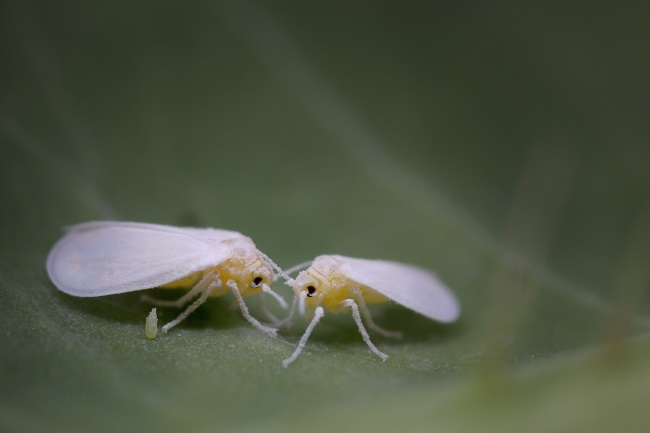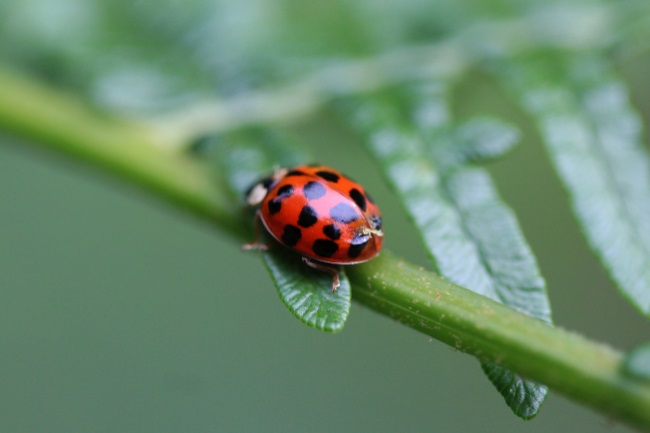Ladybug larvae eat largely the same food as they will when they become adult ladybugs. This means the vast majority eat aphids, whitefly and scale insects. However, a small proportion will eat plant matter, pollen and fungus.
Contents
What is a ladybug larva?

A larva is a juvenile form, which an animal species may take before developing into an adult. They are mostly very different and distinct from the shape they will end up in. Examples would include caterpillars, which turn into butterflies and moths, and maggots, which become flies. All ladybird species start as an egg, which hatches into a larva. The larva then spends several weeks eating as much as they can, going through several instars (growth forms) where they shrug off their exoskeleton so they can become bigger and stronger. Eventually, they will pupate and become an adult.
Also read: How do Ladybugs Reproduce? (From Egg, Larvae to Pupa)
What do ladybug larvae eat?
The purpose of an adult insect is to mate and produce young, thus continuing the cycle. Some adult insects are so heavily designed only to carry out this one aim, that they aren’t even able to eat, such as mayflies.
| Ladybug Species | Larval Diet |
|---|---|
| Coccinella septempunctata | Aphids, mealybugs, scale insects |
| Hippodamia convergens | Aphids, scale insects, mites |
| Harmonia axyridis | Aphids, scale insects, mites, whiteflies |
| Adalia bipunctata | Aphids, scale insects, mealybugs |
| Chilocorus stigma | Scale insects, spider mites, mealybugs |
The primary purpose of the larvae, by comparison, is to eat as much as physically possible. The ‘Very Hungry Caterpillar’ was, in this sense, a very realistic portrayal. How well a ladybug larva gets fed can significantly alter its prospects as an adult from whether it is likely to survive through the winter lean-time to whether any ladybugs of the opposite sex will find it attractive.

In part, a larva’s luck at finding a quick snack is left up to its mother. As ladybug larvae don’t have wings, they can’t easily move between different plants to find food, as the adults do. They have legs to walk their way to the next meal, but this can be a treacherous and time-consuming journey. To give them the best chance in life, therefore, the ladybug female will lay the eggs near what she thinks is a reliable food source. Once they hatch, it’s therefore just a race to consume as much as possible as quickly as possible.
Like father like son
Many insect larvae will eat a completely different diet from their parents. This can be because the environments they live in are so different or that they require distinct things from their meals.
The larvae of the stag beetle (Lucanus cervus), for example, live in rotten logs and will eat decaying wood. However, the adult form will survive on tree sap and spends more of its time out and about. Ladybugs eat largely the same diet as a larva as they do as an adult.
The ladybug’s first meal
Many insect parents like to leave their young a little snack to get them going when they are first born. Unlike mammals, these parents aren’t going to provide nutritious milk for their offspring, so instead, they give them whatever they have to hand. For dung beetles, that might be a delicious ball of poo, whereas the female earwig will even tend to her young, bringing them tasty snacks herself.
The ladybug is a less caring parent, not returning once she’s laid her eggs. However, she also lays a few unfertilised eggs in the brood as a snack for whichever larvae get to them first.
Also read: Do Ladybugs Eat Plants? (Explained)
Aphids

Ladybugs are most known for consuming vast amounts of aphids, which they get a large amount of praise for. One of our most famous ladybugs, the seven-spot ladybug (Coccinella septempunctata), is an avid aphid eater, as are less famous species such as the pink spotted lady beetle (Coleomegilla maculata) and the eye-spotted lady beetle (Anatis Mali). Luckily there are enough aphids to go around, with approximately 5,000 species worldwide. They occur pretty much everywhere, though they mainly thrive in temperate climates. What makes them so successful is their ability to reproduce asexually, with females giving birth to clones of themselves. Most aphids are female, and males are largely only produced during a sexual generation. This generation can mate and produce eggs to start the cycle all over again.
Whitefly

There are around 1,500 species of whitefly globally. These small insects are difficult to control because of their size, generally 1-2mm (0.03-0.07). The adults are winged and can quickly move between plants. However, the larvae are mostly stationary, attached to the plant they are sucking sap from. In many whitefly species, unfertilised eggs hatch as males, which can then be mated to produce fertilised eggs. Like aphids, they can also create clones. Few ladybugs seem to specialise in whiteflies alone; however, many consume them as part of their general diet, the cream-spot ladybug (Calvia quatuordecimguttata) being a prime example.
Scale insects
Scale insects are sapsuckers, like aphids, named for the hard scales, which protect females’ bodies. There are over 8,000 species, and many of them are significant pests to crops. Like aphids, they produce honeydew and can have beneficial relationships with ant species. Male and female scale insects take very different forms, with the males resembling small flies, whilst the females are flightless and covered in their protective armour. Many ladybug species will eat scale insects as a part of their diet, though few seem to specialise specifically in them. The mealybug ladybug (Cryptolaemus montrouzieri), however, has a particular preference for this type of scale insect. Mealybugs are unusual as the females do not carry the typical scales their relatives are known for.
Fungus and plant matter
Around 10% of ladybugs eat solely plant or fungus matter. Many of those who eat plants are infamous amongst farmers and gardeners for the damage they do. The 28 spotted potato ladybug (Epilachna vigintioctopunctata) attacks the leaves of the potatoes, turnips, beans and squashes, and other related species. The larvae tend to concentrate on the undersides of the leaves, whereas the adults will attack the surface. Fungus-eating species tend to be less well-know, as their habits have little impact on human agriculture. The 16 spot ladybug (Tytthaspis sedecimpunctata) primarily feeds on mildews that grow on plants within the umbellifer group, though it also eats some nectar and pollen.
| Food Source | Role in Larval Diet |
|---|---|
| Soft-bodied Insects | Such as whiteflies, thrips, and spider mites |
| Moth Eggs | Including moth caterpillar eggs |
| Pollen and Nectar | Supplementary food source and energy boost |
| Honeydew | Sugary substance produced by aphids and scale insects, which can be consumed by ladybug larvae |
Other ladybugs
Amongst the ladybug’s less appealing characteristics is their tendency towards cannibalism. Most ladybug larvae, if given a reasonable advantage, will eat other ladybug larvae and eggs. The most famous for this is the harlequin ladybug or Asian ladybug (Harmonia axyridis), which is voracious in its consumption of other ladybug species. It’s believed to be eating them into extinction.

Ladybug larvae are eating machines, with their primary purpose in life being to consume as much as possible as quickly as possible. This can be an excellent thing when they’re eating all your pests away, but also a catastrophe if they’re munching down on your favourite cucumber plants.

